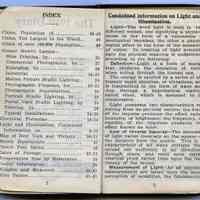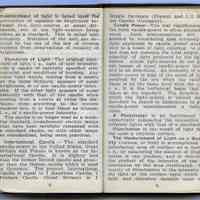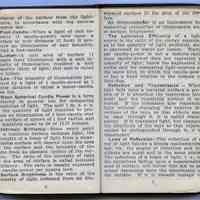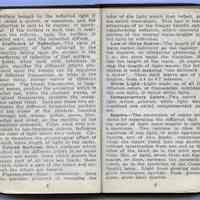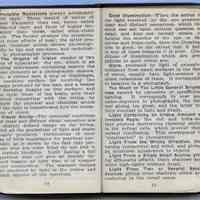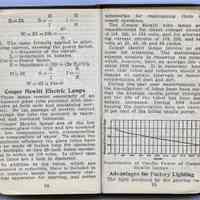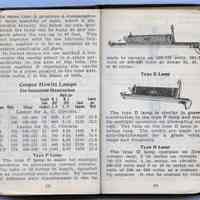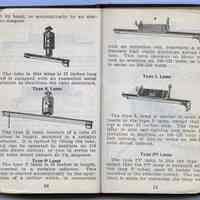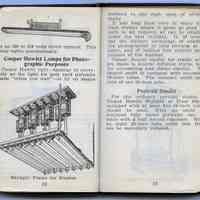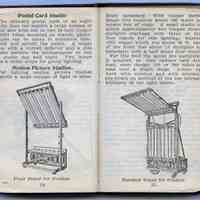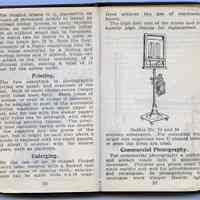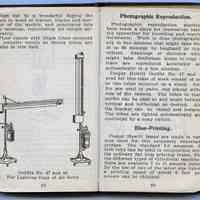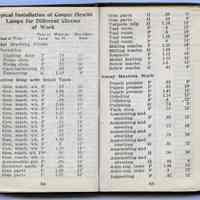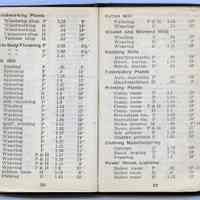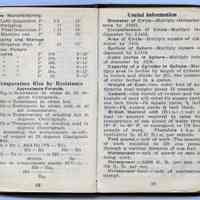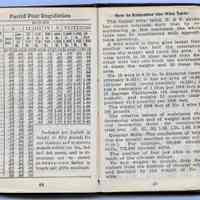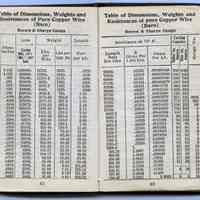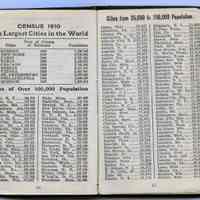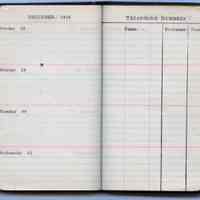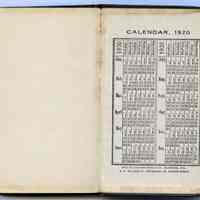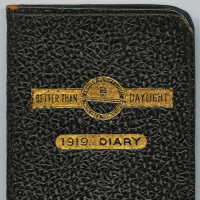Collections Item Detail
Diary, pocket: The 1919 Diary. Issued by the Cooper Hewitt Electric Co. General Offices & Works, Eighth & Grand Sts., Hoboken, N.J.
2013.033.0001
2013.033
Whitford Family
Gift
Gift in memory of Charles Wilson Whitford by the Whitford Family. In Memory of: Gift in memory of Charles Wilson Whitford by the Whitford Family.
1918 - 1919
Date(s) Created: 1918 Date(s): 1918-1919
Good
Notes: Archives 2013.033.0001 Selected text only that is related to the Cooper Hewitt Electric Co., Hoboken. ==== page [1] The 1919 Diary Issued by the Cooper Hewitt Electric Co. General Office and Works Eighth and Grand Streets Hoboken, N. J. DISTRICT SALES OFFICES Boston, Mass. 141 Summer Street Chicago, III. 215 Fisher Building Cincinnati, O. First Nat. Bank Building Cleveland, O. Engineers Building Detroit, Mich. Ford Building Los Angeles, Cal. Keese Engr. Corp. Milwaukee, Wis. 1011 Majestic Building Philadelphia, Pa. Drexel Building Pittsburgh, Pa. Westinghouse Building St. Louis, Mo. Central Nat. Bank Bldg. ==== page 2 Index Cities, Population of............................46-48 Cities, Ten Largest in the World.. 46 Cities of over 100,000 Population.. 46 Cooper Hewitt Lamps— Blue Printing, by................................29 Commercial Photography, by... 27 Enlarging, by........................................26 Industrial ..............................................14-22 Motion Picture Studio Lighting.. 24 Photographic Purposes, for...... 22-23 Photographic Reproduction............29 Portrait Studio Lighting, by________23 Postal Card Studio Lighting, by 24 Printing, by............................................26 Typical Installations..........................34-38 Electrical Formulae................................13-14 Light and Illumination, Condensed Information on......................................3-13 Map of New York and Vicinity... 30-31 Metric Equivalents..................................45 Parcel Post Rates..................................40 Rates of Postage....................................32-33 Temperature Rise by Resistance.. 38 Useful Information..................................39 Weights and Measures........................44-45 Wire Tables................................................41-43 ==== excerpt from page 13 Cooper Hewitt Light Insures a "Flat Production Curve"—This has been demonstrated by fourteen years use in practically every branch of industrial lighting. It is attributed to the fact that the Cooper Hewitt lamp is free from glare, and that the light contains no red rays, which overheat the retina and reduce the sharpness of the image, thereby producing mental and physical fatigue. Cooper Hewitt light has been found to surpass daylight for many purposes where particularly sharp vision is required. ==== excerpts from pages 14-15 Cooper Hewitt Electric Lamps These lamps consist essentially of an exhausted glass tube provided with electrodes at both ends and containing mercury. By the passage of electric current through the tube the mercury is vaporized and rendered luminous. Cooper Hewitt lamps are of the low pressure, glass tube type and are operated at low temperature with corresponding low temperature of vapor. To obtain the maximum efficiency the glass tubes have to be made 50 inches long for operation in multiple, or two 20-inch tubes operating in series on 110 volts. In either case the tubes are 1 inch in diameter. In addition to the tubes, which are mounted in reflectors, there is included in the complete lamps the necessary electrical apparatus for starting, and series ---- accessories for maintaining them in steady operation. The Cooper Hewitt tube lamps are manufactured for direct current circuits of 110, 220, to 550 volts, and for alternating current circuits of 110, 220, and 440 volts at 25, 40, 50 and 60 cycles. Cooper Hewitt lamps involve no expense for trimming. The maintenance expense consists in renewing the tubes, which, however, have an average life of about 5000 hours. It is necessary, however, that tubes and reflectors should be cleaned at certain intervals to removo accumulation of dust and dirt. During the past year improvements In the manufacture of tubes have been such that the average candle power throughout the life of the tubes has been materially increased. During 2000 hours burning the depreciation does not exceed 20 per cent of the initial candle power. [chart] Depreciation of Candle Power of Cooper Hewitt Lamps. Advantages for Factory Lighting The light produced by the glowing va-15 ==== text page 16 por in these lamps differs radically from that of all other electric lamps. It contains practically no red rays but is composed of blue, green and yellow rays, thus giving a greenish-blue color. The greatest portion of the visible light lies in the line 546 at the point of the spectrum where the eye is most efficient. These lamps operate at relatively low temperatures at the same time maintaining high penetrative power and in this respect are not duplicated in any other type of lamp. In industrial plants where Cooper Hewitt lamps are used this peculiar color composition of the light gives important advantages in enabling the eye to see small objects and fine details with the lowest intensity. (1) It increases acuity of vision enabling the eye to see small objects and fine details with greater sharpness than ordinary white light. (2) It enables the eye to see distinctly with considerable less intensity of illumination, that is, in much dimmer light. (3) It is the easiest on the eyes, for the eyes can see with less strain and fatigue, inasmuch as they are not burdened with the red rays which have comparatively little effect in aiding vision but fatigue the eye through their heating action. (4) The Cooper Hewitt lamp is the only commercial light source that does not dazzle the eyes when used without any accessory for diffusing its light. At ==== text pages 18-19 the same time it produces a comparatively large quantity of light, which it distributes broadly, but below its own level. Hence the lamp can be hung at any distance above the eye up to 40 feet. This fact together with its low intrinsic brilliancy, enables it to be so installed as to remove practically all glare. In curves shown the one marked A represents the candle power in a plane perpendicular to the axis of the tube, the curve marked B represents the candle power in a plane parallel to the tube axis, while curve C is the mean of both. Cooper Hewitt Lamps For Industrial Illumination Walts per Length M. L. M. I. lumen Tube HSP HSP Total per Type Watts Voyage (inches) C. P. C. P. Lumens Watt Lamps for A. C. Circuits. F 385 100-460 50 850 0.47 5340 13.9 E 200 100-460 35 400 0.50 2510 12.5 Lamps for D. C. Circuits. H 193 100-125 21 300 0.64 1880 9.T K 385 100-125 45 700 0.55 4400 11.4 P 385 100-125 50 850 0.48 5340 lb.9 L 220 100-125 35 400 0.55 2510 11.4 PP 770 200-250 50 1500 0.47 9420 12.3 Type F Lamp The type F lamp is made for multiple operation on alternating current circuits. The tube is 50 inches in length, mounted in an enamelled steel reflector. By means of different auto transformers it can be ---- made to operate on 100-120 volts, 200-240 volts or 400-460 volts at either 25, 40, 50 or 60 cycles. Type E Lamp The type E lamp is similar in genera! construction to the type P lamp and made for multiple operation on alternating' current. The tube on the type E lamp is 35 inches long. The outfits are made with auto-transformers for a given voltage range and frequency. Type H Lamp The type H lamp operates on direct current only, 2 in series on circuits of 100-125 volts, 4 in series on circuits of 200-250 volts and 9 or 10 in series on circuits of 500 or 600 volts, at a current of 3 1/2 amperes. It can be started by tilting ==== text pages 20-21 it by hand, or automatically by an electro-magnet. The tube in this lamp is 21 inches long and is equipped with an enamelled metal reflector to distribute the light downward. Type K Lamp The type K lamp consists of a tube 45 inches in length, mounted in a suitable reflector. It is lighted by tilting the tube, and can be operated in multiple on 110 volts direct current, or two in series on 220 volts direct current at 3% amperes. Type P Lamp The type P lamp is 50 inches in length, mounted in a suitable reflector. This lamp is started automatically by the operation of a shifter which, in connection ---- with an induction coil, transmits a momentary high static discharge across the tube. This lamp operates on direct current in multiple on 100-125 volts, or two in series on 200-250 volts. Type L Lamp The type L lamp is similar in most respects to the type P lamp, except that It has a tube 35 inches long. The type L lamp is also self-lighting and made for operation in multiple on 100-125 volts direct current, or two in series on 200-250 volts direct current. Type PP Lamp The type PP lamp is like the type P, except that the PP lamp is equipped with two type P tubes, each 50 inches long, mounted in the reflector-holder. The auxiliary is made for operating the lamp out- ==== text pages 22-23 fit on 200 to 250 volts direct current. This lamp lights automatically. Cooper Hewitt Lamps for Photographic Purposes Cooper Hewitt light—familiar to everybody as the light for post card portraits made "while you wait"—is by no means Skylight Frame for Studios ---- confined to the rush class of photography. It has long been used in many hig.H class studios where it gives as good results in all respects as can be obtained under the best skylight. It, of course, has the distinct advantage of enabling the photographer to take pictures at all hours, and of making him entirely independent of the weather. Cooper Hewitt outfits for studio work are made in several different styles, both for alternating and direct current. The largest outfit is equipped with seventeen 50-inch tubes. The smallest outfit consists of one 20-inch tube. Portrait Studio For the ordinary portrait studio, a Cooper Hewitt Skylight or Floor Stand equipped with at least five 50-inch tunes should be used. With an outfit so equipped fully timed portraits can be made with a half second exposure. With an eight 50-inch tube outfit this time can be materially reduced. ==== text pages 24-25 Postal Card Studio The ordinary postal card, or all night studio does not require a large volume of light, and with one or two 50-inch Cooper Hewitt tubes mounted on stands, photographs can be taken in minimum time, which will satisfy the public. A single lamp with a curved reflector and a side screen permits the photographer to run his studio day and night. Two lamps give a wider scope for group lighting. Motion Picture Studios. For lighting motion picture studios properly a large volume of light is abso- Floor Stand for Studios. ---- lutely necessary. With Cooper Hewitt lamps this requires about 100 watts per square foot of stage. A small studio requires approximately five Cooper Hewitt skylights overhead, with three or foiir floor stands for side lighting; whereas with stages which run about 40 ft. back of the front line about 15 skylights are necessary, with a half dozen floor stands. For this field the lamps are particularly adapted, as they radiate very little heat, even though 150 or 200 tubes are used over a single stage. Actors can work with comfort and with minimum eye-strain on account of the low intrinsic brilliancy of the light source. Elevator Stand for Studios ==== text pages 26-27 For studios where it is impossible on account of structural details to install an overhead trolley system to carry skylight outfits, so called elevator stands either with or without wings can be furnished. This stand can be raised to a point so that the tubes are 18 ft. from the floor. It consists of a frame containing nine 50-inch tubes controlled by a raising and lowering device a,nd if desired, wings can be added to the sides consisting of 8 additional tubes, making a total of 17 tubes for the entire outfit. Printing. The two essentials in photographic printing are speed, and evenness of the print. Both of these requirements Cooper Hewitt tubes meet fully. Short tubes of 20 inches, or even 10 inches if necessary, can be adapted to most of the automatic printing machines when rapid paper is used, and for use with the slower papers longer tubes can be arranged, with racks for holding printing frames. The printing time naturally varies with the density of the negative and the grade of the paper, but it might be said that about 5 seconds is required with the rapid papers, and about 5 minutes with the slower papers, such as platinum. Enlarging, By the use of an M-shaped Coopef Hewitt tube, covered with a flashed opal glass or piece of tracing cloth, enlargements can be made from 8 x 10 nega- ---- tives without the use of condensing lenses. The high first cost of the lenses and the equally high charge for replacement is Outfits No. 54 and 64 entirely eliminated. For enlarging from larger size negatives two U-shaped tubes, or even the three are used. Commercial Photography. For commercial photography a uniform and always ready light is absolutely necessary. Pictures and prints must bo made rapidly and well for advertisements and catalogues. In photographing for catalogue work Cooper Hewitt light ==== text pages 28-29 brings out to a wonderful degree the grain in wood or leather, shades and contour of the models, and penetrates into the recesses, reproducing all details accurately. Floor stands with single tubes mounted on movable stands as shown below are useful in this field. Outfits No. 47 and 46 For Lighting Copy of All Sorts ---- Photographic Reproduction. Photographic reproduction machines have made a place for themselves beside the typewriter for recording and copying documents. Work is done photographically in five minutes that might take from 30 to 60 minutes by longhand or typewriters. Drawings or sketches which might take draftsmen hours to copy or trace are reproduced accurately and authentically in a few minutes. Cooper Hewitt Outfits No. 47 and 45 used for this class of work consist of one or two tubes mounted on a stand. Outfits are used in pairs, one placed either side of the camera. The tubes in these outfits can be used at any angle between vertical and horizontal as desired. Also the bracket can be raised and lowered. The tubes are lighted automatically and controlled by a snap switch. Blue-Printing. Cooper Hewitt lamps are made in various sizes for this extremely important process. The standard 3.5 amperes, 50 inch tube can be used in conjunction with the ordinary flat blue printing frame. For the different types of cylindrical machines there are available 7 to 15 ampere tubes. By the use of two of the latter size tubes, a printing speed of about 6 feet per minute can be obtained. ==== excerpt text page 32 Cooper Hewitt Electric Company The general offices and works of this company are located at 8th and Grand street, Hoboken, N. J. The foregoing map of the lower portion of New York City and the New Jersey shore of the Hudson River shows the location with reference to the railroads, subways, ferry boats and surface lines. To reach the works take the Hudson Tubes or Ferry to Hoboken Terminal of Delaware, Lackawanna and Western R. R. At this point take car marked Willow and get off at 8th and Clinton Streets. Walk one block west to 8th and Grand Streets. Twenty minutes from Broadway and Cortland Street, New York. ==== ==== page 34 Typical Installation of Cooper Hewitt Lamps for Different Classes of Work Type of Watts per Feet Above Class of Work— Lamp Sq. Ft. Floor Metal Working Plants Foundries. Casting floor F .74 11' Forge shop F .74 11' Forge shop P .77 10' Case hardening H .82 12' Tempering K 1.28 9' Machine Shop with Small Tools Gen. mach. wk. F .92 12' Gen. mach. wk. F 1.04 10' Gen. mach. wk. F .99 10' Gen. mach. wk. F .89 10' Gen. mach. wk. F 1.05 ' 25' Gen. mach. wk. F 1.14 15' Gen. mach. wk. F 1.27 12' Gen. mach. wk. F 1.35 9' Gen. mach. wk. F .85 24' Gen. mach. wk. F .94 14' Gen. mach. wk. F .91 16' Gen. mach. wk. F .82 12' Gen. mach. wk. F 1.02 30' Gen. mach. wk. P .8 12' Gen. mach. wk. P 1.23 14' Gen. mach. wk. PP .91 25' Gen. rnach. wk. L .85 12' Automobile pts. F .92 13' Revolver parts F .95 10' Gun parts P 1.80 12' Gun parts P 1.37 12' ==== page 35 Gun parts H .88 9' Gun parts H .89 9' Torpedo mfg. H 1.18 14' Tool room F .8 12' Tool room F .8 10' Tool room F 1.48 10' Tool room P .8 14' Milling machs. F 1.15 10' Milling machs. H 1.09 7' Reamers F 1.12 10' Model making F 1.12 10' Screw machs. P 1.0 12' Screw machs. H .81 8' Heavy Machine Work Punch presses F .95 9' Punch presses F .83 10' Punch presses P 1.07 12' Grinding F 1.14 12' Polishing F .8 .12' Polishing H .74 9' Tank shop F .75 12' Assembling and erecting F .89 15' Assembling and erecting F .77 36' Assembling and erecting P .79 16' Assembling and erecting H .81 12' Assembling and erecting H .94 10' Assembling and erecting H .88 9' Auto eng. tests F 1.95 12' Auto eng. tests F .9 12' Inspecting F .82 12' ==== page 36 Woodworking Plants Woodwkg. shop P 1.28 8' Woodworking H .91 10' Woodworking H .96 10' Carpenter shop H .83 10' Varnish shop H .82 10' Auto Body Finishing F 2.28 8 1/2' " " P 2.86 8 1/2' " " P 2.23 7' Silk Mill Reeling F .95 9' Spinning F .8 12' Spinning F 1.52 10' Spinning P 1.0 12' Spinning P 1.47 10' Spinning P 1.02 12' Spinning K 1.4 10' Spinning H 3.02 10' Silk throwing F 1.0 .. Winding P 1.28 12' Warping P 1.11 12' Warping P 1.16 12' Warping P 1.08 10' Quill winding P 1.51 10' Entering P 1.65 12' Weaving F 1.37 10' Weaving P 1.0 14' Weaving P 1.27 11' Weaving P 1.21 11' Weaving P 1.30 11' Weaving P & H 1.47 12' Weaving P & H 1.18 14' Weaving P & H 1.15 8' Weaving P & H 1.6 11' Ribbon loom H 1.54 9' Picking P 1.65 12' ==== page 37 Cotton Mill Twisting P & H 1.68 12' Weaving P .74 12' Woolen and Worsted Mills Winding P .94 10' Weaving H .78 9' Weaving K 1.13 10' Knitting Mills Knittingmachs. P .94 10' Stitch. machs. P 1.33 10' Stitch. machs. P .94 10' Embroidery Plants Auto. machines F .95 14' Hand machines H .98 9' Printing Plants Comp. room P 2.3 12' - Comp. room P 1.51 12' Comp. room P 1.93 10' Comp. room P & H 1.84 10' Comp. room PI 1.7 10' Stereotype rm. P 1.03 12' Stereotype rm. P 1.77 10' News. presses H .84 8'-14' News. press. P & H .82 27' . Job presses P 1.19 12' Engrav. presses P 1.82 10' Clothing Manufacturing Cutters P 1.72 10' Hand sewing F 1.74 10' Pressing F 1.6 10' Power House Lighting Boiler room F .61 16'-22' Boiler room H .6 18' Boiler room H 1.18 12' ==== excerpt page 38 Glass Manufacturing Lehr inspection P 2.0 12' Stripping P .71 15' Final inspection P 1.28 10' Machine cut. F .85 12' Shipping and Storage Shipping dept. P .49 12' Motion Picture Studios P 100. 8'- 10' " " P 128. 8'- 14' " " P 100. 8'- 15' " " P 99. 8'- 13' " " P 104. 8'- 13' " " P 89. 8'- 12' ==== ==== Status: OK Status By: dw Status Date: 2013-06-05


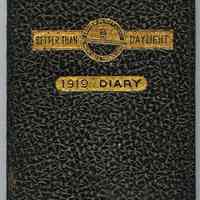
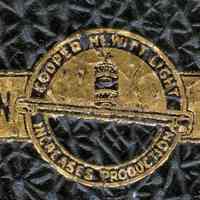
![inside front cover + pg [i]](https://d3f1jyudfg58oi.cloudfront.net/11047/image/a06d59b0-fabc-11ed-a641-b3912f9925a9-uFfaeXV.tn.jpg)
![pg [ii] + [1] title](https://d3f1jyudfg58oi.cloudfront.net/11047/image/a19eadc0-fabc-11ed-a641-b3912f9925a9-uFfafDt.tn.jpg)
